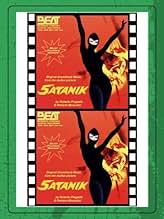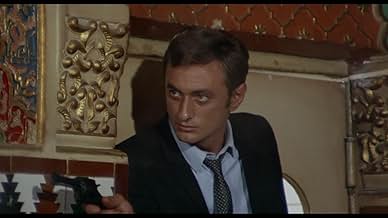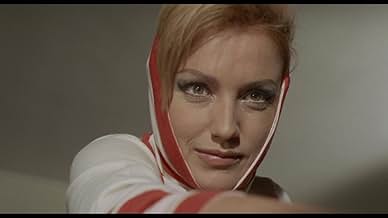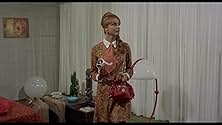Füge eine Handlung in deiner Sprache hinzuA withered old hag turns into a beautiful young woman after drinking a youth formula.A withered old hag turns into a beautiful young woman after drinking a youth formula.A withered old hag turns into a beautiful young woman after drinking a youth formula.
Pino Polidori
- Albert
- (as Joe Atlanta)
Empfohlene Bewertungen
A brilliant scientist by the name of "Professor Greaves" (Nerio Bernardi) has just invented a serum that rejuvenates cells and reverses the aging process. His assistant, "Dr. Marny Bannister" (Magda Konopka) desperately wants the formula due to the fact that she is scarred and ugly. However, Professor Greaves is cautious and wants to do more research before even attempting to try it out on a human being. Dr. Bannister then kills Professor Greaves and ingests the serum which turns her into the young and beautiful woman she always wanted to be. But there are two important factors which Dr. Bannister failed to take into account. First, the formula unleashes savage and primordial desires into whoever takes it. The second factor is that the serum wears off after a period of time and the person reverts back to their previous form. What follows is a murderous rampage by Dr. Bannister who is not averse to using her beauty to further her evil desires. Although it was originally filmed in Italian, the English dubbing was very noticeable. Also quite noticeable was the fact that a scene or two was cut rather abruptly. This gave the film a kind of choppy feel. Still, Magda Konopka looked great and the film had a nice late-60's atmosphere to it. All things considered I give it an average rating.
Many of the other reviewers cite the suspect quality of this release on Retromedia. I just purchased this title from Sinister Cinema and the print quality is very good. The color is not as vivid as one would prefer but is not washed out in the least. Considering the movie is almost 40 years old the color of the print is really quite fine. The print has no jump cuts or jarring splices, the audio and video are in perfect sync and the print runs a full 84 minutes.My rating is specifically for overall print quality. As with most other reviewers, I found the movie a bit tedious but I'm glad that I watched it and own a copy. Kudos to Sinister Cinema as they are a consistent class act in regards to making hard to find titles available in the best possible presentation. Their Krimi releases are especially outstanding!
Starting from a fairly common inspiration, we see Dr. Marnie Bannister (Magda Konopka) kill a scientist to recover the formula for a potion that brings new youth. She then becomes the young and beautiful Satanik. Then Dr. Bannister transforms into Satanik after drinking the potion: not only does she change her appearance, but the potion also changes her clothes and covers her with makeup and false eyelashes. Police Inspector Trent (Julio Peña) and Commissioner González (Armando Calvo) and on their heels. Based on the fumetti of Magnus and Max Bunker, highlighting Satanik's vengeful personality, his thirst for revenge against those who have wished him harm. A true heroine of evil, although her name is never spoken!
After the success of Fantomas and later Danger Diabolik, an adaptation of fumetti (Italian comic) and others, the producers felt that they had to continue with the vein. Until 1970, Italian screens were flooded with masked heroes, from the two Kriminales, the most extravagant ones like Superargo vs Diabolikus and Baba Yaga, to the parody Arriva Dorellik, an unequivocal sign of the end of a cycle. These films were entertaining and fun with twisted plots that combined a Mexican-type masked wrestler with the James Bond-style European spy subgenre. The heroines were missing, which is why Satanik appeared on the screen. It is a somewhat monotonous adaptation based on comics, known in Italy as Fumetti, based on a script in which elements from the previous films intervene here and there. Kriminal's cinematic counterpart, Satanik, addresses a theme of physical transformation that we have already seen in theaters through B movies like Wasp Woman and Leech Woman. Mixing here the classic myths of Dr. Jekyll and Mr. Hyde or even the Picture of Dorian Gray, but counting on the pragmatism of the authors of transalpine comics, who allow themselves the transgressive power that modern times offer, we have the right to excesses without precedents. . But unfortunately this adaptation is of mediocre quality, because Satanik suffers from comparison with Danger Diabolik and, unfortunately, is of less interest. It must be taken into account that in France fumetti is also known as "Demoniak", Satanik being the French version of the Italian "Killing".
It is the qualitative and creative opposite of Fantomas, the film inevitably belongs to the criminal genius genre. There is a certain imbalance during the 81 minutes, as if the authors had wanted to suddenly precipitate the action and quasi-eroticism of the end of the film. Between the decisions of an apathetic police force and the lack of real stakes, director Vivarelli fails to give depth to the film. Apart from deliberate or unintentional atrocities, such as The sensuality, mystery, danger and symbiosis that emanated from the adventures of the Diabolik/Eva Kant couple, for example, are almost absent here. Even the absence of morality, which is also a big part of fumetti's charm, is cemented as a lesson in virtue for the audience. Satanik's seductive outfits and vague zooms of him don't make much of an impression and the film ends up being a parable about waste. Instead of transcending the pop material, the film embraces a linearity and little imagination in the images that will disappoint more than one. Aside from a fun striptease scene and the rarity of the product for lovers of vintage Italian cinema from the '60s, Satanik may not excite many people.
There is atmospheric retro-pop-lounge music by Manuel Parada , which will delight fans, some unconventional images and along with the inevitable flamenco scene (mandatory Spanish co-production), adding endless jazz pieces. Produced by Eduardo Manzanos Brochero, who wrote/financed several Spanish-Italian co-productions. Manzanos built a small western town in Hoyo De Manzanares (Madrid) where shot uncountable Spaghettis with sets by Jaime Pérez Cubero and José Luis Galicia, who were also in charge of Satanik's sets. To play Satanik, Vivarelli turns to the beautiful Magda Konopka, who, coincidentally or not, bears a certain resemblance to Marisa Mell, who plays Eva Kant in Danger Diabolik. Like the countless shooting stars of popular cinema, he had his moment of glory in the particularly rich decade of 1965/1975. Satanik is probably his most striking work, although we already saw it in the credits of ¨When the Dinosaurs Ruled the Earth¨, ¨Lucky Luciano¨ and the classic Spaghetti ¨The Blind Man¨, before slowly sliding through its twilight, sailing between light thrillers as ¨Diabolicamente...Letizia¨ and subgenres like Nunsploitation, softcore and cheap Giallos. Here, she carries out the task with class and firmness, giving Bannister/Satanik different personalities, and co-stars Spaniards like Julio Peña as a bloodhound police inspector, Antonio Pica and former 1940s heartthrob Armando Calvo.
The film was average but professionally directed by Piero Vivarelli. At times using pseudonym Donald Murray, only had limited resources at his disposal, and we're left with a fairly flat and unengaging adventure that often seems to be little more than a standard crime movie with a comic book character attached. He also tried his luck with Mister X , but that project still suffered from some of the same shortcomings and failures. A screenwriter since the early 1950s, Vivarelli stepped behind the camera in 1960 for a very opportunistic San Remo La grande Sifida, about the San Remo Song Festival. Passing the stage of collaborating on the script for Django, he also posted Emanuelle in America, Emanuelle Nera: Orient Reportage, and directed some secondary films such as El Dio serpente, El Decameron negro, La Rumbera, Provocazione. And Piero makes a small appearance here under the guise of Inspector Leduc. For the curiosities of the credits, it is Benito Mussolini's son who produced the film and the assistant director is none other than Pupi Avati. The film was a public and critical failure, and it's easy to see why in retrospect.
After the success of Fantomas and later Danger Diabolik, an adaptation of fumetti (Italian comic) and others, the producers felt that they had to continue with the vein. Until 1970, Italian screens were flooded with masked heroes, from the two Kriminales, the most extravagant ones like Superargo vs Diabolikus and Baba Yaga, to the parody Arriva Dorellik, an unequivocal sign of the end of a cycle. These films were entertaining and fun with twisted plots that combined a Mexican-type masked wrestler with the James Bond-style European spy subgenre. The heroines were missing, which is why Satanik appeared on the screen. It is a somewhat monotonous adaptation based on comics, known in Italy as Fumetti, based on a script in which elements from the previous films intervene here and there. Kriminal's cinematic counterpart, Satanik, addresses a theme of physical transformation that we have already seen in theaters through B movies like Wasp Woman and Leech Woman. Mixing here the classic myths of Dr. Jekyll and Mr. Hyde or even the Picture of Dorian Gray, but counting on the pragmatism of the authors of transalpine comics, who allow themselves the transgressive power that modern times offer, we have the right to excesses without precedents. . But unfortunately this adaptation is of mediocre quality, because Satanik suffers from comparison with Danger Diabolik and, unfortunately, is of less interest. It must be taken into account that in France fumetti is also known as "Demoniak", Satanik being the French version of the Italian "Killing".
It is the qualitative and creative opposite of Fantomas, the film inevitably belongs to the criminal genius genre. There is a certain imbalance during the 81 minutes, as if the authors had wanted to suddenly precipitate the action and quasi-eroticism of the end of the film. Between the decisions of an apathetic police force and the lack of real stakes, director Vivarelli fails to give depth to the film. Apart from deliberate or unintentional atrocities, such as The sensuality, mystery, danger and symbiosis that emanated from the adventures of the Diabolik/Eva Kant couple, for example, are almost absent here. Even the absence of morality, which is also a big part of fumetti's charm, is cemented as a lesson in virtue for the audience. Satanik's seductive outfits and vague zooms of him don't make much of an impression and the film ends up being a parable about waste. Instead of transcending the pop material, the film embraces a linearity and little imagination in the images that will disappoint more than one. Aside from a fun striptease scene and the rarity of the product for lovers of vintage Italian cinema from the '60s, Satanik may not excite many people.
There is atmospheric retro-pop-lounge music by Manuel Parada , which will delight fans, some unconventional images and along with the inevitable flamenco scene (mandatory Spanish co-production), adding endless jazz pieces. Produced by Eduardo Manzanos Brochero, who wrote/financed several Spanish-Italian co-productions. Manzanos built a small western town in Hoyo De Manzanares (Madrid) where shot uncountable Spaghettis with sets by Jaime Pérez Cubero and José Luis Galicia, who were also in charge of Satanik's sets. To play Satanik, Vivarelli turns to the beautiful Magda Konopka, who, coincidentally or not, bears a certain resemblance to Marisa Mell, who plays Eva Kant in Danger Diabolik. Like the countless shooting stars of popular cinema, he had his moment of glory in the particularly rich decade of 1965/1975. Satanik is probably his most striking work, although we already saw it in the credits of ¨When the Dinosaurs Ruled the Earth¨, ¨Lucky Luciano¨ and the classic Spaghetti ¨The Blind Man¨, before slowly sliding through its twilight, sailing between light thrillers as ¨Diabolicamente...Letizia¨ and subgenres like Nunsploitation, softcore and cheap Giallos. Here, she carries out the task with class and firmness, giving Bannister/Satanik different personalities, and co-stars Spaniards like Julio Peña as a bloodhound police inspector, Antonio Pica and former 1940s heartthrob Armando Calvo.
The film was average but professionally directed by Piero Vivarelli. At times using pseudonym Donald Murray, only had limited resources at his disposal, and we're left with a fairly flat and unengaging adventure that often seems to be little more than a standard crime movie with a comic book character attached. He also tried his luck with Mister X , but that project still suffered from some of the same shortcomings and failures. A screenwriter since the early 1950s, Vivarelli stepped behind the camera in 1960 for a very opportunistic San Remo La grande Sifida, about the San Remo Song Festival. Passing the stage of collaborating on the script for Django, he also posted Emanuelle in America, Emanuelle Nera: Orient Reportage, and directed some secondary films such as El Dio serpente, El Decameron negro, La Rumbera, Provocazione. And Piero makes a small appearance here under the guise of Inspector Leduc. For the curiosities of the credits, it is Benito Mussolini's son who produced the film and the assistant director is none other than Pupi Avati. The film was a public and critical failure, and it's easy to see why in retrospect.
The level of success of SATANIK as a film is entirely dependant upon the audience viewing it. An audience expecting something along the lines of OPERAZIONE PAURA or CASTLE OF BLOOD will be disappointed. This isn't a horror film. Even an audience expecting a giallo in the Argento / Fulci tradition is bound to be dissatisfied by the lack of creative violence and relatively mild gore. In 1968 the target audience for this film were the readers of the hugely successful fumetti neri that had already led to popular cinematic spin-offs of DIABOLIK and KRIMINAL. When viewed in this light, SATANIK becomes a much more successful, though no better, film.
In most respects the film is fairly faithful to its literary origins. Marny Bannister, a brilliant but horribly disfigured scientist, ingests a chemical formula that transforms her into a beautiful, but soulless, homicidal femme fatal. Though the base premise relies upon science fiction rudiments, the stories in the original comics tended more towards the Rialto Edgar Wallace krimis than any genre effort by Antonio Margheriti. Horror elements did crop up in the comic, notably the Dorian Gray like character Alex Bey and Satanik's long running battle with the vampire, Count Wurdalak, but such fantastical story lines were interspaced with more conventional crime thrillers. It is from the latter that SATANIK the film takes its inspiration.
It is easy to dismiss the movie as Dr. Jekyll and Mr. Hyde done up as a travelogue, but it is unlikely that film audiences familiar with the comic original would have been disappointed. In terms of plot all the fundamentals have been transferred from the comic into the screenplay, with some scenes lifted almost verbatim. The casting of the central role is excellent. The beautiful Magda Konopka displays both the proper malicious delight in her newfound beauty and callous disregard for her pawns and victims and even very much resembles her comic book counterpart. Where the film falls short is in structure, directorial ambition, and resolution.
Other than the avaricious desires of our central character, there really is no central narrative to the film. To its detriment, it is more a series of episodes, strung loosely together. While the same criticism could be easily leveled against the film version of DIABOLIK, that film enjoyed superior pacing and visual interest thanks to the brilliance of director Mario Bava. Indeed Bava could have done much for SATANIK as the direction of Piero Vivarelli is only workmanlike throughout, lacking in ambition and dynamism. The most blatant weakness of the film is its final few minutes. The ending of the film seems hurried, hackneyed and uninspired, owing more to a bland requirement to see justice done at the end then to provide a satisfying conclusion. Something akin to the last moments of SILENCE OF THE LAMBS or the original HALLOWEEN would have been far more effective.
This film is available on DVD in North America in an unspectacular, cropped 4:3 English dubbed release. A superior widescreen DVD release is currently available in Europe, with the original Italian audio track. The Italian DVD has no English audio or subtitles.
Historical Note: SATANIK is closely adapted from the Italian comic series created in 1964 by writer Max Bunker and artist Magnus (pseudonym of Roberto Raviola). In the same year the pair also created the character "Kriminal" whose modus operandi and skull and bones costume were usurped by the character "Killing" two years later. When the fumetti Killing stories were reprinted in France the character was renamed "Satanik" and eventually "Sadistik" in America. This character was brought to film as "Kilink" in a series of productions from Turkey. The original Satanik series was renamed "Demoniak" when reprinted in France, so as not to be confused with the already existing "Satanik" title. And of course an entirely different character called "Demoniak" already exited in Italy.
In most respects the film is fairly faithful to its literary origins. Marny Bannister, a brilliant but horribly disfigured scientist, ingests a chemical formula that transforms her into a beautiful, but soulless, homicidal femme fatal. Though the base premise relies upon science fiction rudiments, the stories in the original comics tended more towards the Rialto Edgar Wallace krimis than any genre effort by Antonio Margheriti. Horror elements did crop up in the comic, notably the Dorian Gray like character Alex Bey and Satanik's long running battle with the vampire, Count Wurdalak, but such fantastical story lines were interspaced with more conventional crime thrillers. It is from the latter that SATANIK the film takes its inspiration.
It is easy to dismiss the movie as Dr. Jekyll and Mr. Hyde done up as a travelogue, but it is unlikely that film audiences familiar with the comic original would have been disappointed. In terms of plot all the fundamentals have been transferred from the comic into the screenplay, with some scenes lifted almost verbatim. The casting of the central role is excellent. The beautiful Magda Konopka displays both the proper malicious delight in her newfound beauty and callous disregard for her pawns and victims and even very much resembles her comic book counterpart. Where the film falls short is in structure, directorial ambition, and resolution.
Other than the avaricious desires of our central character, there really is no central narrative to the film. To its detriment, it is more a series of episodes, strung loosely together. While the same criticism could be easily leveled against the film version of DIABOLIK, that film enjoyed superior pacing and visual interest thanks to the brilliance of director Mario Bava. Indeed Bava could have done much for SATANIK as the direction of Piero Vivarelli is only workmanlike throughout, lacking in ambition and dynamism. The most blatant weakness of the film is its final few minutes. The ending of the film seems hurried, hackneyed and uninspired, owing more to a bland requirement to see justice done at the end then to provide a satisfying conclusion. Something akin to the last moments of SILENCE OF THE LAMBS or the original HALLOWEEN would have been far more effective.
This film is available on DVD in North America in an unspectacular, cropped 4:3 English dubbed release. A superior widescreen DVD release is currently available in Europe, with the original Italian audio track. The Italian DVD has no English audio or subtitles.
Historical Note: SATANIK is closely adapted from the Italian comic series created in 1964 by writer Max Bunker and artist Magnus (pseudonym of Roberto Raviola). In the same year the pair also created the character "Kriminal" whose modus operandi and skull and bones costume were usurped by the character "Killing" two years later. When the fumetti Killing stories were reprinted in France the character was renamed "Satanik" and eventually "Sadistik" in America. This character was brought to film as "Kilink" in a series of productions from Turkey. The original Satanik series was renamed "Demoniak" when reprinted in France, so as not to be confused with the already existing "Satanik" title. And of course an entirely different character called "Demoniak" already exited in Italy.
Deformed, aged female scientist kills fellow scientist in order to steal formulae for rejuvenating cells and reversing the aging process. She takes it and turns into the beautiful, evil Satanik (Magda Konopka) who goes around, seducing and murdering wealthy businessmen.
She dresses very stylishly in late-60s mod clothes and manipulates those around her, looking a lot like the late Marisa Mell from the DIABOLIK film. Coincidence??
However, in spite of all this, it's amateurish and sloppy without the James Bond pop-art gadgetry that DIABOLIK had had. Even the Madrid and Lake Geneva filming locations don't make up for this.
The soundtrack is by Manuel Parada & Roberto Pregadio and it isn't bad at all, consisting of lush orchestration with a little fuzz guitar used as an embellishment. Perfect for one of those European Loungecore CDs that came out in the 90s.
The Retromedia DVD also uses a substandard grainy color print that's in poor shape, with an explanation at the beginning saying that this was due to the age of the film. Bull ! They either didn't bother looking for a better source or they couldn't find one at all. There are only a few stills of Magda and that's it.
Sloppy & poor all around, this one gets a 3 out of 10.
She dresses very stylishly in late-60s mod clothes and manipulates those around her, looking a lot like the late Marisa Mell from the DIABOLIK film. Coincidence??
However, in spite of all this, it's amateurish and sloppy without the James Bond pop-art gadgetry that DIABOLIK had had. Even the Madrid and Lake Geneva filming locations don't make up for this.
The soundtrack is by Manuel Parada & Roberto Pregadio and it isn't bad at all, consisting of lush orchestration with a little fuzz guitar used as an embellishment. Perfect for one of those European Loungecore CDs that came out in the 90s.
The Retromedia DVD also uses a substandard grainy color print that's in poor shape, with an explanation at the beginning saying that this was due to the age of the film. Bull ! They either didn't bother looking for a better source or they couldn't find one at all. There are only a few stills of Magda and that's it.
Sloppy & poor all around, this one gets a 3 out of 10.
Wusstest du schon
- WissenswertesPupi Avati, who worked on a film as an assistant director, declared that watching Piero Vivarelli at work taught him how to not direct a movie.
- VerbindungenFeatured in Late Movie 18: Satanik (1980)
Top-Auswahl
Melde dich zum Bewerten an und greife auf die Watchlist für personalisierte Empfehlungen zu.
- How long is Satanik?Powered by Alexa
Details
- Laufzeit
- 1 Std. 26 Min.(86 min)
- Sound-Mix
- Seitenverhältnis
- 2.35 : 1
Zu dieser Seite beitragen
Bearbeitung vorschlagen oder fehlenden Inhalt hinzufügen




























